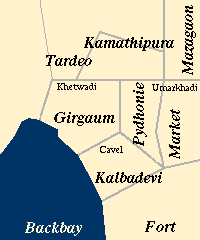Mumbai
Quick links

See also the overview of the Inner City.
There was a Koli fishing hamlet in the eastern part of present day Mandvi (near Zakaria Masjid) till the coming of the British. Before reclamations started this was a low-lying area below the rocky heights of Dongri, and provided easy access to the sea. Muslim settlers are known to have lived in the higher lands near present day Chakla and Market, and in Dongri, from the fourteenth century.
Umarkhadi, to the north of this region, was a creek separating the island of Bombay from Mazagaon until the end of the seventeenth century. When the British took possession of these islands, there was probably a bridge across Umarkhadi, and there had been attempts to dam it. It was probably reclaimed by the end of the seventeenth century, in 1700.
On Dongri hill there was a Portuguese fort, which the British took over and fortified. The temple of Mumbadevi was originally situated on the hill, but was moved several times before it found its present location in Pydhonie.
After the fall of the Portuguese fort of Bassein in 1739, an Esplanade and parade ground was cleared from the walls of the fort almost upto present day Crawford Market. The Indian part of the town was pushed back towards the northern end of the island, near the Flats, which were inundated at every high tide. These lands were reclaimed only after the middle of the century, in 1784, with the construction of the Hornby Vellard at Breach Candy. Mandvi was settled almost immediately.
The Jama Masjid, originally built near Dongri fort was moved to the Esplanade somewhere near the middle of this century and forced out from there by the British in the 1770's. The first story of the present structure, was begun in 1775, and completed 33 years later. The upper storey was added in 1837. Samaji Hasaji (Samuel Ezekiel), a Bene Israeli, built the Gate of Mercy Synagogue in 1796. It moved to its present location forty years later and gave the name to the area called Masjid Bunder.
Through the nineteenth century Market took on the character it now has. Three major cloth markets developed in these crowded quarters, as did retail trade of all varieties. The eastern part of Bombay island was predominantly Muslim for a long time, and remains so even today.